-
ORIGINAL ARTICLE08-08-2022
(Re)Construction of the body of transgender women: daily search for (in)satisfaction and care?
Revista Brasileira de Enfermagem. 2022;75(6):e20210512
Abstract
ORIGINAL ARTICLE(Re)Construction of the body of transgender women: daily search for (in)satisfaction and care?
Revista Brasileira de Enfermagem. 2022;75(6):e20210512
DOI 10.1590/0034-7167-2021-0512
Views1See moreABSTRACT
Objective:
To analyze the structure and contents of transgender women’s social representations of their bodies and body modification practices.
Methods:
Research conducted with 92 women using the Snowball technique. The data were collected using the free evocation of words technique and processed by the Evoc software, which organized the central and peripheral elements.
Results:
The representation of the real body includes two structuring aspects: one related to the need to adapt/modify the body conformation according to the self-reported gender, because of the dissatisfaction with the body itself; the second reveals the happiness/satisfaction considering the results obtained through the body modification/adaptation practices adopted in the transition.
Final considerations:
The body is constituted as a complex object and was represented by elements that reinforce the understanding of body modifications as needs, with a view to satisfaction, personal fulfillment, and care of one’s own body.
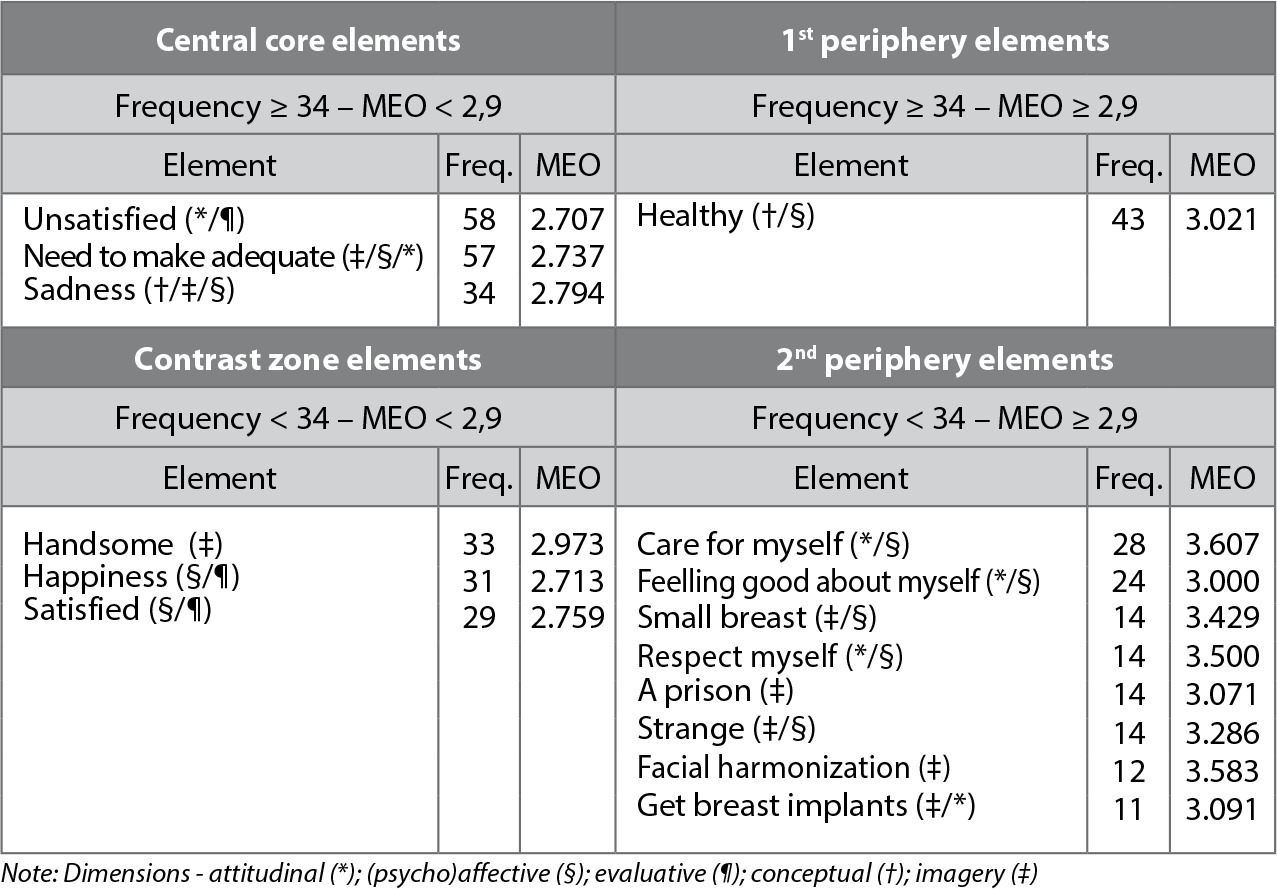
-
ORIGINAL ARTICLE08-08-2022
Social and territorial inequalities in the mortality of children and adolescents due to COVID-19 in Brazil
Revista Brasileira de Enfermagem. 2022;75(6):e20210482
Abstract
ORIGINAL ARTICLESocial and territorial inequalities in the mortality of children and adolescents due to COVID-19 in Brazil
Revista Brasileira de Enfermagem. 2022;75(6):e20210482
DOI 10.1590/0034-7167-2021-0482
Views0See moreABSTRACT
Objective:
To analyze the mortality rate of COVID-19 among children and adolescents aged 0 to 14 years.
Methods:
Ecological and exploratory study of children’s mortality rate by COVID-19 in Brazil, from February to October 2020. The study used the Severe Acute Respiratory Syndrome database to collect the data and made the analysis using descriptive spatial statistics by age and race/color classification.
Result:
The mortality rate due to COVID-19 represented 1.34 deaths per one hundred thousand in the total group evaluated. The age group with the highest frequency and mortality rate was 1 to 4 years of age. There is a higher frequency of deaths in the brown and Indigenous population.
Conclusion:
The distribution of deaths due to COVID-19 is unequal in the national territory, and there is a wide variation in the mortality rate by age and race/color groups.
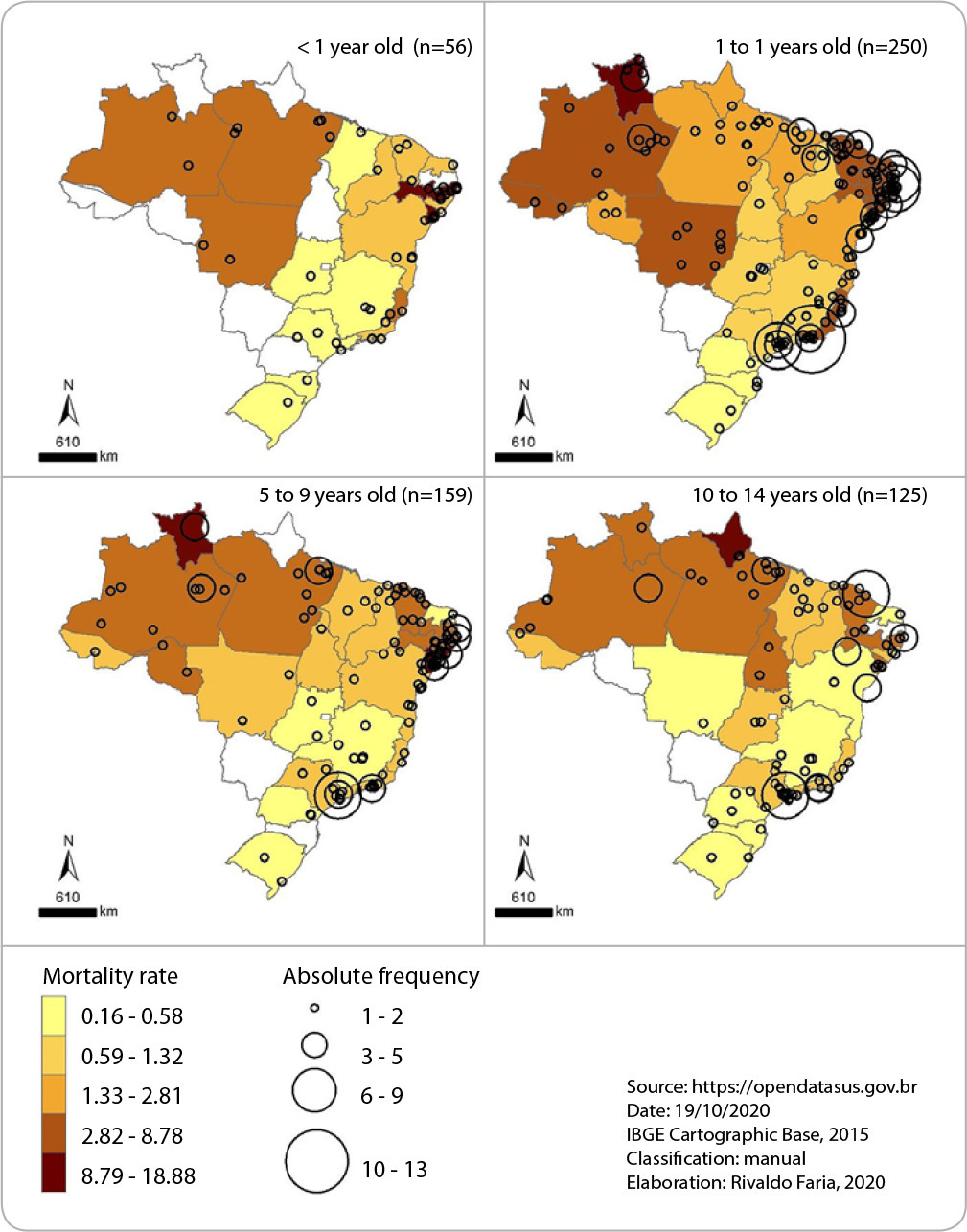
-
ORIGINAL ARTICLE08-08-2022
Repercussions of COVID-19 on the daily lives of women living in a rural settlement
Revista Brasileira de Enfermagem. 2022;75(6):e20220021
Abstract
ORIGINAL ARTICLERepercussions of COVID-19 on the daily lives of women living in a rural settlement
Revista Brasileira de Enfermagem. 2022;75(6):e20220021
DOI 10.1590/0034-7167-2022-0021
Views0See moreABSTRACT
Objective:
To understand the repercussions of COVID-19 on women’s daily lives in a rural settlement.
Methods:
A qualitative study was conducted in a rural settlement of the Landless Workers’ Movement (MST) in a municipality in Northeastern Brazil between January and March 2021. Forty-eight women participated through semi-structured interviews. The data collected were analyzed by the Collective Subject Discourse method in light of the referential of pandemic processes.
Results:
The grouping of the speeches unveiled similar and/or complementary meanings about the coping strategies and the feelings generated due to the pandemic. Four Central Ideas were organized: denial to progressive awareness; Perception of the problem, acceptance, and explanation of reality; Negotiation; and Retrospection/reflection.
Conclusion:
The pandemic repercussions are intrinsically related to an inhospitable reality from the perspective of the experience of women daily forgotten, marginalized, and suppressed.
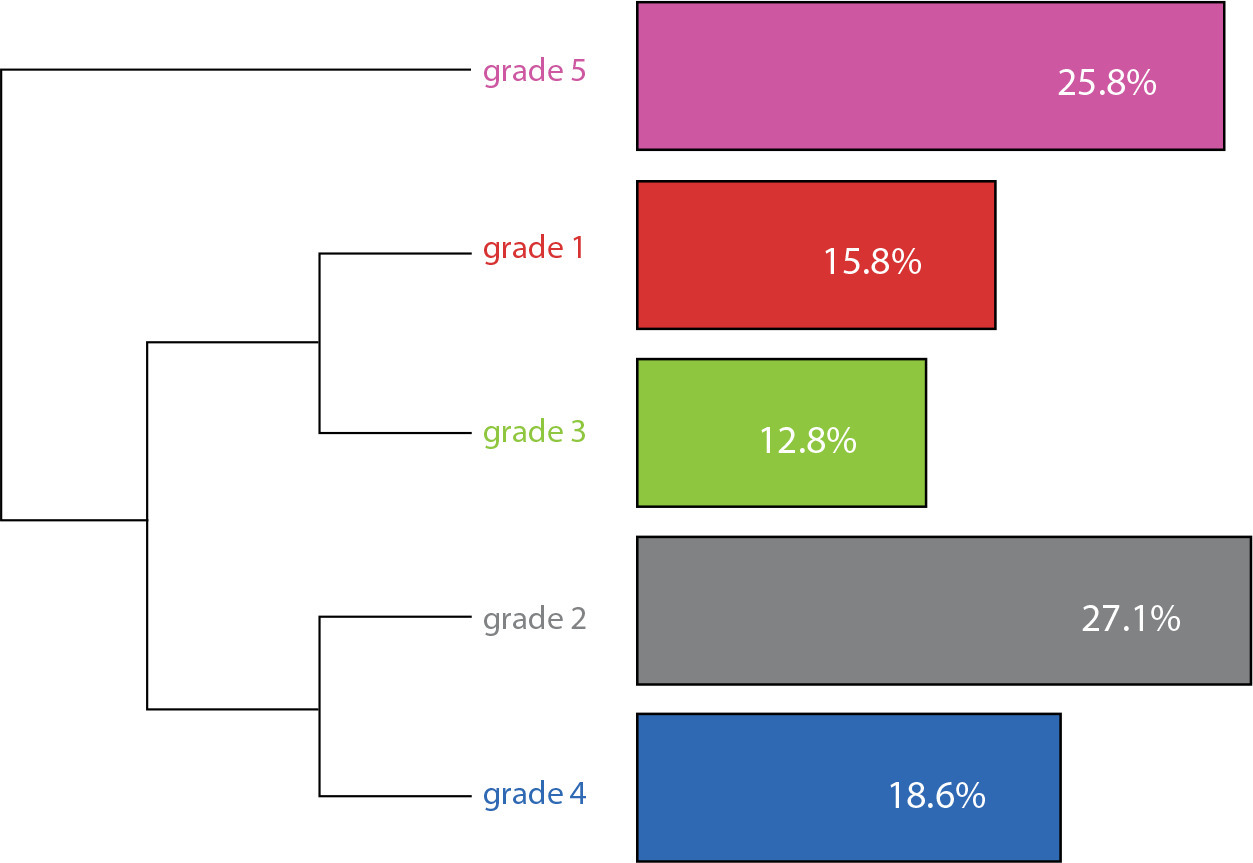
-
ORIGINAL ARTICLE08-08-2022
Factors associated with frailty syndrome in elderly people with Parkinson’s disease
Revista Brasileira de Enfermagem. 2022;75:e20220096
Abstract
ORIGINAL ARTICLEFactors associated with frailty syndrome in elderly people with Parkinson’s disease
Revista Brasileira de Enfermagem. 2022;75:e20220096
DOI 10.1590/0034-7167-2022-0096
Views0See moreABSTRACT
Objectives:
to analyze the sociodemographic and clinical factors associated with frailty in the elderly with Parkinson’s disease in the context of a Specialized Health Care Service for the Elderly.
Methods:
documentary, analytical, correlational, cross-sectional study carried out with 230 elderly people with Parkinson’s. The medical records of the patients were evaluated with a focus on two instruments: Clinical-Functional Vulnerability Index – 20; and the Multidimensional Assessment Care Plan.
Results:
predominance of elderly people between 80 and 89 years old; women; with low education; classified as fragile. There was a correlation between frailty and the variables: sex; age; age group; schooling; motor manifestations; non-motor manifestations; Hoehn and Yahr staging and time to diagnosis.
Conclusions:
high simultaneity of frailty conditions and Parkinson’s disease was observed. It is believed that the results will be able to help the structuring of protocols for nursing performance in a systematic way in the promotion of self-care of these individuals.

-
ORIGINAL ARTICLE08-08-2022
Sexual function positively correlated with older adults’ sexuality and quality of life
Revista Brasileira de Enfermagem. 2022;75:e20210939
Abstract
ORIGINAL ARTICLESexual function positively correlated with older adults’ sexuality and quality of life
Revista Brasileira de Enfermagem. 2022;75:e20210939
DOI 10.1590/0034-7167-2021-0939
Views0See moreABSTRACT
Objectives:
to analyze sexual function and its correlation with sexuality and quality of life in male older adults.
Methods:
a cross-sectional study, developed with 231 male older adults. Participants completed four instruments to obtain biosociodemographic data, sexual function, sexuality and quality of life. Analyzes were performed using the Mann-Whitney test and Spearman Correlation.
Results:
sexual function was positively correlated with sexuality in a moderate magnitude and with quality of life in a low magnitude. Male older adults without sexual dysfunction experienced their sexuality better and had a better quality of life. Finally, partner overall satisfaction was the facet of sexual function that had the highest positive correlation with sexuality, while self-confidence had the highest positive correlation with quality of life.
Conclusions:
we suggest that sexual function should be addressed more frequently in Primary Health Care services, as we found statistically significant correlations with sexuality and quality of life components.
-
REVIEW08-08-2022
Non-pharmacological analgesia strategies in adult and elderly endovascular procedures: a scoping review
Revista Brasileira de Enfermagem. 2022;75:e20210741
Abstract
REVIEWNon-pharmacological analgesia strategies in adult and elderly endovascular procedures: a scoping review
Revista Brasileira de Enfermagem. 2022;75:e20210741
DOI 10.1590/0034-7167-2021-0741
Views0See moreABSTRACT
Objectives:
To identify the main non-pharmacological analgesia strategies used in clinical practice in adult and elderly endovascular procedures.
Methods:
scoping review, undertaken in July 2021, on 12 national and international data sources. The recommendations of the JBI and the Preferred Reporting Items for Systematic reviews and Meta-Analyses extension for Scoping Reviews checklist were followed. Thirteen studies were selected to compose the sample, with no time or language cut-off.
Results:
the main non-pharmacological strategies found were cold compress, use of music, and reflexology. The most prevalent procedures were coronary angiography, peripheral venous catheterization, and femoral catheter removal. Pain measurement by Visual Numeric Scale and Visual Analog Scale described pain reduction in adults and elderly.
Conclusions:
the main non-pharmacological strategies found were cold compress, use of music, and reflexology, which reduce pain in adults and the elderly.
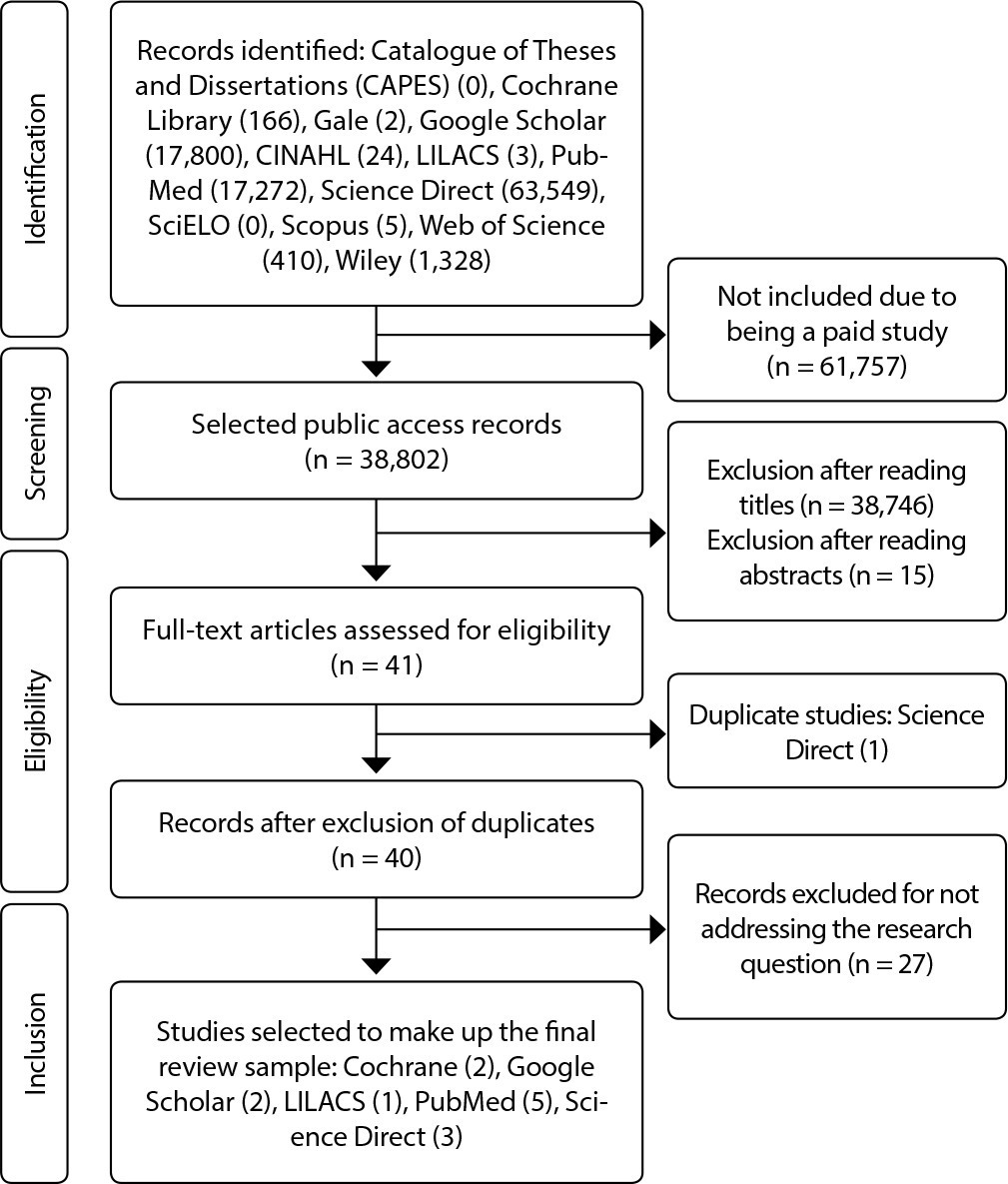
-
08-01-2022
Monkeypox: between precision public health and stigma risk
Revista Brasileira de Enfermagem. 2022;75(5):e750501
Abstract
Monkeypox: between precision public health and stigma risk
Revista Brasileira de Enfermagem. 2022;75(5):e750501
DOI 10.1590/0034-7167.2022750501
Views0The World Health Organization (WHO) is on alert due to an unprecedented Monkeypox outbreak in non-endemic countries, such as Europe, which have been affected recently. Despite the low pandemic potential, the recent SARS-CoV-2 pandemic has contributed to heightened levels of public concern in the face of the threat of new global health emergencies().As of May […]See more -
08-01-2022
Viruela del mono: entre la salud pública de precisión y el riesgo de estigma
Revista Brasileira de Enfermagem. 2022;75(5):e750501
Abstract
Viruela del mono: entre la salud pública de precisión y el riesgo de estigma
Revista Brasileira de Enfermagem. 2022;75(5):e750501
DOI 10.1590/0034-7167.2022750501es
Views0La Organización Mundial de la Salud (OMS) está alerta debido a un brote sin precedentes de Monkeypox, también conocida como viruela del mono, en países no endémicos, como Europa, que se han visto afectados recientemente. A pesar del bajo potencial pandémico, la reciente pandemia de SARS-CoV-2 ha contribuido a aumentar los niveles de preocupación pública […]See more
-
ORIGINAL ARTICLE06-08-2020
Usability of a mobile application on diabetic foot self-care
Revista Brasileira de Enfermagem. 2020;73(4):e20180862
Abstract
ORIGINAL ARTICLEUsability of a mobile application on diabetic foot self-care
Revista Brasileira de Enfermagem. 2020;73(4):e20180862
DOI 10.1590/0034-7167-2018-0862
Views0See moreABSTRACT
Objectives:
to assess the usability of an app prototype for diabetic foot self-care by an end user.
Methods:
a descriptive study that uses heuristic assessment of a hybrid app usability. Fifteen users of an outpatient diabetes care service in a capital of Northeastern Brazil participated in the study during April 2018. The usability measurement tool called Smartphone Usability questionnaiRE was applied.
Results:
the lowest score was 77 and the highest was 112, with an average usability of 96.1 points. Usability was framed in the last two levels, 70 and 8o. Users now strongly agree (level 70) and fully (level 80) with the assessed items, which represents good usability of the apps prototype.
Conclusions:
the final product developed focuses on user needs and requirements, which can ensure usability based on effectiveness, efficiency and satisfaction triad.
-
08-19-2019
Clinical simulation in nursing education in intensive therapy: an integrative review
Revista Brasileira de Enfermagem. 2019;72(4):1061-1070
Abstract
Clinical simulation in nursing education in intensive therapy: an integrative review
Revista Brasileira de Enfermagem. 2019;72(4):1061-1070
DOI 10.1590/0034-7167-2018-0217
Views0See moreABSTRACT
Objective:
to analyze the publications on clinical simulation practices for education in Nursing in Intensive Care.
Method:
an integrative review carried out through LILACS, PubMed, Cochrane Library, CINAHL and SciELO databases, of articles published from 2008 to 2017.
Results:
29 articles were selected, of which 76% discuss the use of simulation in continuing education of nursing professionals, while the others describe their use for student education. There is a higher prevalence of studies with a level of evidence 6 (17), with 28 international publications. There was an increase in scientific production, with 16 articles published in the last three years.
Conclusion:
variables after simulation use, such as confidence, communication skills, efficiency in the identification of clinical worsening of patients, development of technical skills, teamwork and clinical decision-making, presented a significant improvement, demonstrating that this tool is effective in qualifying care for critical patients.
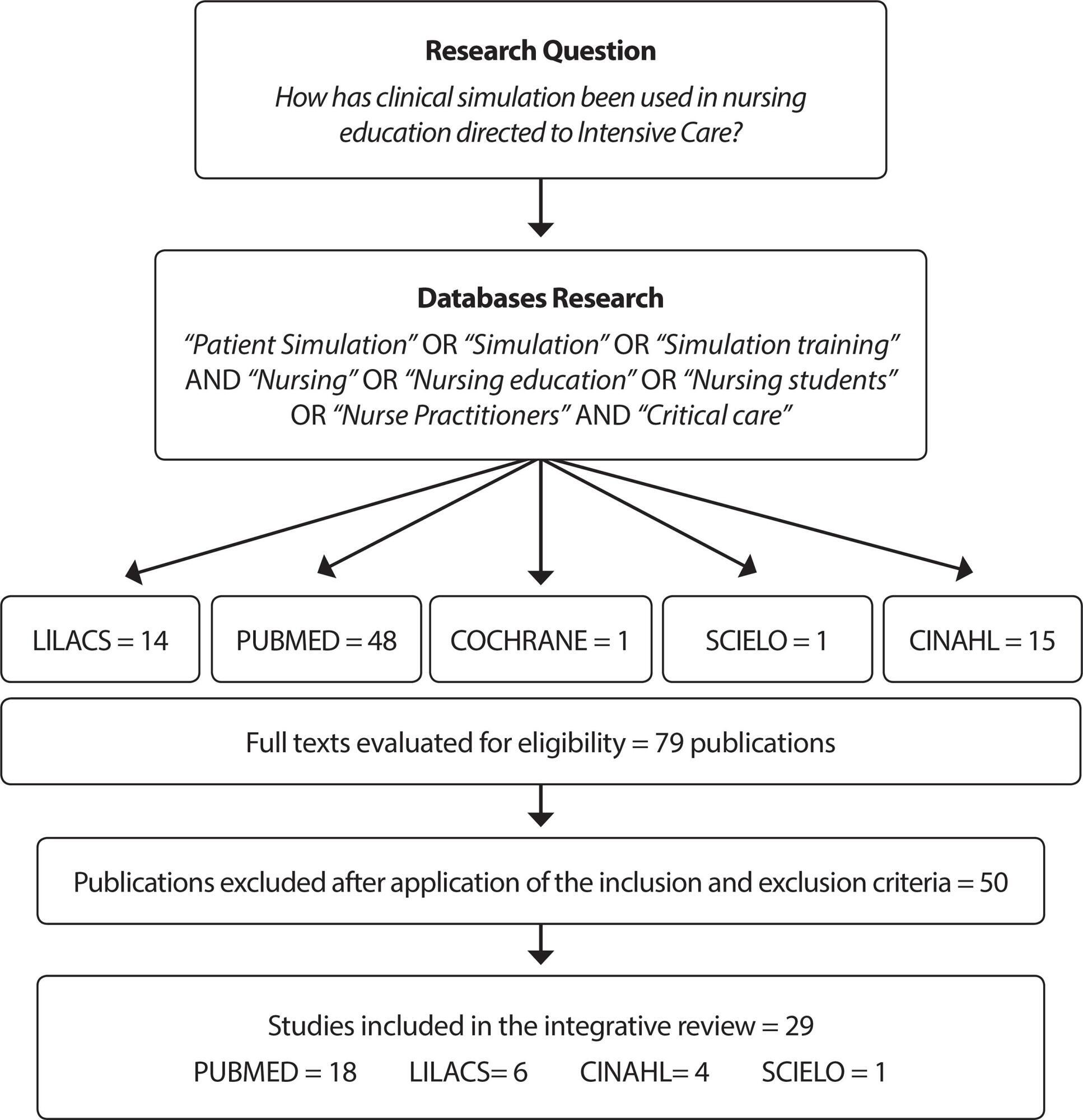
-
ORIGINAL ARTICLE09-16-2019
Social incentives for adherence to tuberculosis treatment
Revista Brasileira de Enfermagem. 2019;72(5):1182-1188
Abstract
ORIGINAL ARTICLESocial incentives for adherence to tuberculosis treatment
Revista Brasileira de Enfermagem. 2019;72(5):1182-1188
DOI 10.1590/0034-7167-2017-0654
Views0See moreABSTRACT
Objective:
To analyze the influence of social incentives for adherence to tuberculosis (TB) treatment.
Method:
Qualitative study, in which 26 primary health care professionals of São Paulo were interviewed in 2015.Their testimonies were submitted to the speech analysis technique. The theoretical reference was the social determination of the health-disease process. Ethical procedures were observed.
Results:
TB is related to precarious living conditions. Incentives such as the basic food basket and transportation stipends are relevant for patients’ adherence to treatment, as well as to the create bonds between the patient and the health team.
Final considerations:
The incentives strengthened adherence to TB treatment. However, interventions in the context of public measures must transcend the remedial dimension and be guided towards the transformation of the TB situation, which means supporting processes that modify living conditions.
-
REFLECTION05-03-2021
Florence Nightingale’s theory and her contributions to holistic critical thinking in nursing
Revista Brasileira de Enfermagem. 2021;74(2):e20200139
Abstract
REFLECTIONFlorence Nightingale’s theory and her contributions to holistic critical thinking in nursing
Revista Brasileira de Enfermagem. 2021;74(2):e20200139
DOI 10.1590/0034-7167-2020-0139
Views0See moreABSTRACT
Objective:
to reflect on Florence Nightingale’s legacy and describe her contributions to critical holistic thinking in nursing.
Methods:
this is a theoretical reflection, for which scientific productions on Florence Nightingale’s environmental theory, as published in national and international journals, were based.
Results:
Florence Nightingale’s philosophy and teachings emphasize that the nurse must use her brain, heart and hands to create healing environments to care for the patient’s body, mind and spirit. Nursing, since the time of Nightingale, has been building the holistic paradigm, in all schools of thought, with a view to a humanistic approach to the human being in their indivisible relationship with the environment.
Final considerations:
Florence’s contributions to holistic critical thinking in nursing are evident, constituting nurses’ differential in clinical practice.
-
ORIGINAL ARTICLE07-01-2020
Homeless population: characterization and contextualization by census research
Revista Brasileira de Enfermagem. 2020;73(5):e20190236
Abstract
ORIGINAL ARTICLEHomeless population: characterization and contextualization by census research
Revista Brasileira de Enfermagem. 2020;73(5):e20190236
DOI 10.1590/0034-7167-2019-0236
Views0See moreABSTRACT
Objectives:
to analyze characteristics of homeless people and factors associated with living on the streets.
Methods:
a census-type sectional survey carried out between 2015 and 2018, in the municipality of Maringá-Paraná. A total of 701 homeless answered a structured questionnaire with sociodemographic data, living conditions, and drug use. We used Pearson’s correlation test for the association analysis of the variables at a 95% confidence level.
Results:
men (90.7%) the average age of 37.7 years had been homeless for an average of 5.39 years. Most had little education (54.2%), and homelessness was due to drug use (47.2%) and family disagreements (38.9%).
Conclusions:
drug use and family disagreements were the main reasons for homelessness. Time on the street, gender, and drugs were associated with a negative correlation to be homeless; and age, mean daily income, the number of daily meals, having been in prison, and having an income source were associated with positive correlation.
-
ORIGINAL ARTICLE10-21-2019
Religious/spiritual coping and spiritual distress in people with cancer
Revista Brasileira de Enfermagem. 2019;72(6):1534-1540
Abstract
ORIGINAL ARTICLEReligious/spiritual coping and spiritual distress in people with cancer
Revista Brasileira de Enfermagem. 2019;72(6):1534-1540
DOI 10.1590/0034-7167-2018-0585
Views0See moreABSTRACT
Objective:
To investigate the relation between the presence of spiritual distress and use of RSC and sociodemographic, clinical and religious/spiritual variables in people with cancer.
Method:
Cross-sectional study conducted in an association for support to people with cancer. The data obtained with the tools were analyzed using the Spearman‘s correlation coefficient and the Mann-Whitney Test.
Results:
129 volunteers participated in the study, of which 57% showed moderate spiritual distress, 96% used medium and high positive religious/spiritual coping. Spiritual distress showed positive correlation with negative religious/spiritual coping (P<0.001) and inverse correlation with age (p 0.002). The use of positive religious coping was statistically significant in people who have religious practices (p 0.001).
Conclusão:
Spiritual distress is a phenomenon that is present in the lives of people with cancer and has significant relation with the use, in a negative manner, of religion/spirituality as a way of coping with the disease.
-
REVIEW06-26-2023
Barriers to Pre-Exposure Prophylaxis (PrEP) use for HIV: an integrative review
Revista Brasileira de Enfermagem. 2023;76(3):e20210963
Abstract
REVIEWBarriers to Pre-Exposure Prophylaxis (PrEP) use for HIV: an integrative review
Revista Brasileira de Enfermagem. 2023;76(3):e20210963
DOI 10.1590/0034-7167-2021-0963
Views0See moreABSTRACT
Objectives:
to identify and synthesize scientific evidence on the barriers and difficulties for Pre-exposure Prophylaxis (PrEP) use and compliance for HIV.
Methods:
an integrative literature review, using the MEDLINE/PubMed, Cumulative Index to Nursing and Allied Health Literature (CINAHL), Academic Search Premier and Scopus (Elsevier) databases.
Results:
all (100%) the articles included identified that PrEP users experience some type of structural barrier related to health services such as long distance from the units, suboptimal logistics for taking pills and professional resistance to prescribing PrEP. Furthermore, 63.21% identified social barriers, such as stigma about sexuality and HIV, in addition to individual barriers such as alcohol use, adverse effects, and concerns about long-term toxicity.
Conclusions:
the barriers to PrEP use are multifactorial. Effective interventions are needed to support PrEP users in accessing, complying with, and retaining health services.
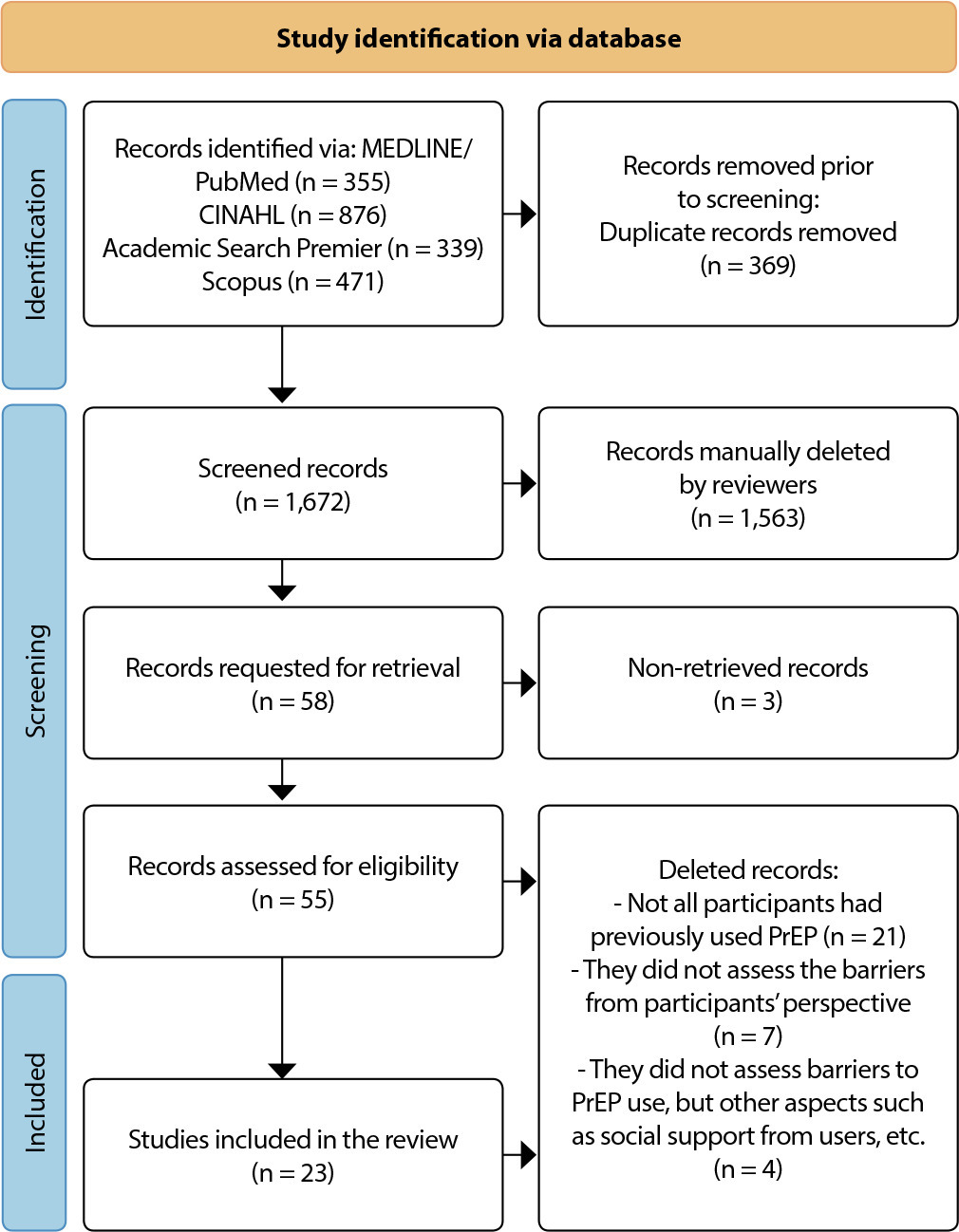
-
EXPERIENCE REPORT10-26-2020
Brazilian Nursing Process Research Network contributions for assistance in the COVID-19 pandemic
Revista Brasileira de Enfermagem. 2020;73:e20200798
Abstract
EXPERIENCE REPORTBrazilian Nursing Process Research Network contributions for assistance in the COVID-19 pandemic
Revista Brasileira de Enfermagem. 2020;73:e20200798
DOI 10.1590/0034-7167-2020-0798
Views0See moreABSTRACT
Objective:
to describe the theoretical construction process of nursing process support documents in COVID-19 care scenarios.
Methods:
an experience report of the joint activity of the Brazilian Nursing Process Research Network (Rede de Pesquisa em Processo de Enfermagem) composed of Higher Education and Health Institution researchers in Brazil.
Results:
five instruments were organized collectively, involving the elements of nursing practice (nursing diagnoses, outcomes and interventions) in assistance for community; for patients (with suspected or mild, moderate, and critical COVID-19 and residents in Nursing Homes); for nursing workers’ health support, also subsidizing registration and documentation during the COVID-19 pandemic.
Final considerations:
valuing the phenomena manifested by families/communities, patients and health professionals is essential for early detection, intervention, and prevention of diseases.
Search
Search in:
Nuvem de Tags
Adolescente (85) Atenção Primária à Saúde (239) COVID-19 (91) Criança (91) Cuidados de Enfermagem (269) Educação em Enfermagem (151) Educação em Saúde (139) Enfermagem (930) Enfermagem Pediátrica (86) Estudantes de Enfermagem (77) Estudos de Validação (131) Família (87) Idoso (208) Promoção da Saúde (99) Qualidade de Vida (104) Saúde do Trabalhador (86) Saúde Mental (145) Saúde Pública (82) Segurança do Paciente (150) Tecnologia Educacional (100)



